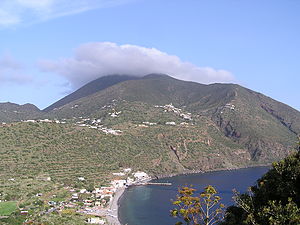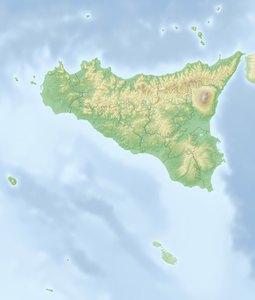Filicudi
| Filicudi | ||
|---|---|---|
| Monte Fossa delle Felci on Filicudi | ||
| Waters | Tyrrhenian Sea | |
| Archipelago | Aeolian Islands | |
| Geographical location | 38 ° 34 '31 " N , 14 ° 33' 30" E | |
|
|
||
| length | 5.4 km | |
| width | 3.1 km | |
| surface | 9.5 km² | |
| Highest elevation | Monte Fossa delle Felci 774 m slm |
|
| Residents | 235 (2001) 25 inhabitants / km² |
|
| main place | Filicudi Porto | |
| The Aeolian Islands | ||
Filicudi and its neighboring islands Lipari , Stromboli , Vulcano , Salina , Panarea and Alicudi belong to the archipelago of the Aeolian Islands , which are located in the Tyrrhenian Sea off the north coast of Sicily .
It belongs to the municipality of Lipari in the metropolitan city of Messina .
geography
The island is 9.5 km² and consists of three inactive volcanic cones, the Monte Fossa delle Felci, with 774 m the highest point on the island, the Montagnola (383 m) and the Torrione (280 m). A small plateau and the Capo Graziano peninsula connect to the southeast . Filicudi is rich in caves such as B. the Grotta del Bue Marino on the southwest coast. Three quarters of the landscape are under nature protection, but without this being monitored.
The ancient name of the island was Phenicusa , as it used to be densely overgrown with fern. Filicudi is the oldest and first inhabited island of the Aeolian archipelago with 1 million year old lava rocks.
The approximately 250 residents and artists who settled here, such as the late Ettore Sottsass or Roland Zoss , lived or live mainly in the southern part in the ports of Filicodi Porto and Pecorini and in Valdichiesa, which is at an altitude of 280 m.
tourism
- In terms of tourism, Filicudi is suitable for swimming, snorkeling, diving and, in autumn, for windsurfing. In addition, botanical hikes and bird watching are possible.
- The rocky cliffs Fortuna, Notaro, Mitra, Montenassari and the rock needle La Canna lie off the northwest coast of Filicudi. This rises 71 m from the sea and attracts extreme climbers from all over the world.
- The old network of trails is well preserved. Almost every corner on the eastern half of the island can be reached on foot. Chapels mark the most important intersections.
- A few years ago, dedicated islanders recognized the cultural, historical and tourist importance of the stone-paved mule tracks and are committed to their care.
- The baroque church of San Stefano in Valdichiesa from the 17th century and the remains of a prehistoric village on Capo Graziano are culturally worth seeing.
- Fifteen foundations of the oval round buildings from the Bronze Age have been preserved.
- Greek inscriptions can be found in the nature reserve of Montagnola.
See also
literature
- Peter Amann: Aeolian Islands . Hiking and enjoying between Etna and Vesuvius. A travel companion. Rotpunktverlag , Zurich 2017, ISBN 978-3-85869-730-1
- Eva Gründel, Heinz Tomek: Lipari Islands. DuMont Reiseverlag, Cologne 2003, ISBN 3-7701-6028-2 .
- Roland Zoss : The island behind the moon - Aeolian story. 2nd edition, ISBN 978-3-9524591-0-2 . Translated into English and French as an e-book Die Insel hinterm Mond , “The Island Beyond The Moon” and “LÎle derrière la lune” . Also from his pen the tree songs , a collection of 28 set to music trees on two albums. Composed on the island. [1]
Web links
Individual evidence





